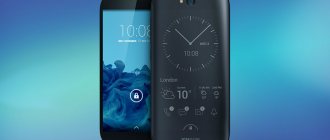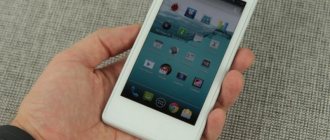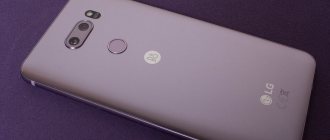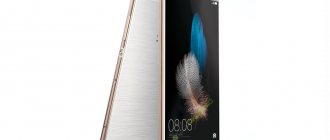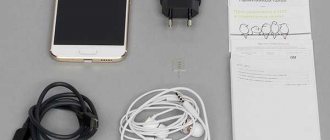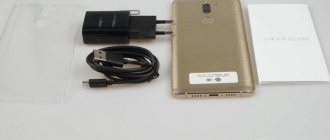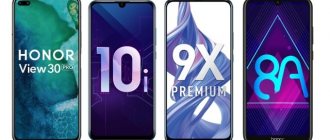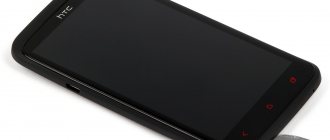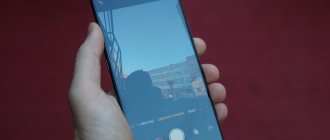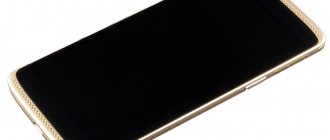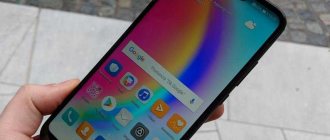Characteristics of Yota YotaPhone 3 in detail
Platform
Chipset Qualcomm Snapdragon 625 (MSM8953) Octa core CPU 8 x ARM Cortex-A53 @ 2.00 GHz 64-bit Yes GPU Adreno 506 @ 650 MHz NPU No Process technology 14nm FinFET (LPP)
Memory
RAM 4 Gb – LPDDR3 @ 933 MHz (Single Channel) Built-in storage 64 Gb/128 Gb – eMMC 5.1 Memory expansion No
Screen
Resolution 1080 x 1920 (FullHD) Aspect ratio 9:16 Matrix type AMOLED Diagonal 5.5″ Area ~83.4 cm2 Fill percentage ~72.2% (of the total front surface area) Pixel density ~401 ppi Security Yes
Connection
Communication standards GSM, UMTS, TD-SCDMA, LTE 2G GSM 850 / 900 / 1800 / 1900 MHz CDMA BC0 3G UMTS B1 2100 MHz, B2 1900 MHz, B5 850 MHz, B8 900 MHz 3G TD-SCDMA B34 2000 MHz, B39 1900 MHz 4G LTE FDD-LTE B1/B3/B5/B7/B8/B20, TDD-LTE: B34/38/B39/B40/B41 (2545 - 2655 MHz) LTE support Yes LTE categories Category-7 DL / Category-13 UL LTE Speed Up to 300 Mbps download, up to 150 Mbps upload LTE device categories indicate the maximum speed at which it can send and receive data on 4G LTE networks through carrier aggregation. Number of SIM cards 2 Type of SIM cards Nano SIM Modem Snapdragon X9 LTE
Cameras
Main camera
Type Single Resolution 12.0 MP Autofocus Yes Aperture No data Features Face Beauty, Face Detection, Panorama Shot LED flash
Front-camera
Resolution 13.0 MP Aperture No data
Interfaces
WiFi IEEE 802.11 a/b/g/n/ac, 2.4 GHz + 5 GHz, Wi-Fi Direct, DLNA, Wi-Fi access point mode is a technology for building wireless local networks based on the IEEE 802.11 family of standards. Supported by all modern smartphones and many mobile phones. Bluetooth v4.2 Bluetooth is a universal wireless interface for exchanging data between various types of devices at close range. Can be used for file transfer, audio streaming, network connection, printing and other purposes. The newer the version, the greater the speed and number of supported profiles. Navigation GPS, A-GPS, GLONASS For at least 10 years, smartphones have supported the geolocation function using data from satellite navigation systems. At the moment, these are the American-developed GPS, the Russian GLONASS, the Chinese BeiDou and the European GALILEO. As a rule, smartphones support the first two and optionally the rest. NFC Yes The built-in NFC module of a smartphone is mainly used for contactless payment in applications like Google Pay and Samsung Pay. Can also be used to read data from contactless cards, transfer files, etc. Read more here. Infrared port No Some smartphones have a built-in IR port. In the past, it was used to synchronize data both between two mobile phones and between a phone and a PC. However, now, due to its low speed, the infrared port is used mainly to control external devices in remote control mode. FM radio Yes Built-in radio receiver that allows you to listen to radio stations operating in the FM range. In most cases, it only works when headphones are connected, since the wire is used as a communication antenna. However, there are devices with a built-in antenna. 3.5 mm audio No Standard audio jack for connecting wired headsets and headphones. Starting in 2020, some smartphone manufacturers, following Apple, began to abandon it. In this case, to connect regular headphones, you need a special adapter for Lightning/USB Type-C. USB USB Type-C, On-The-Go The type of USB connector installed in the smartphone and the capabilities it supports.
Sensors and biometrics
Sensors Electronic compass, Gravity sensor, Gyroscope Fingerprint scanner Yes Scanner location Built into the Home button Scanner response time 0.1 s Face scanner (Face ID) No Iris scanner (IRIS) No
Power supply
Battery capacity 3300 mAh Battery type Li-ion Removable battery No Fast charging Yes Wireless charging No
Software
Operating system Android 7.1 Nougat Shell No Over-the-air (OTA) update Yes Sending messages SMS, MMS, Email, Push Email, IM Internet browser HTML5, CSS, JavaScript Audio formats AAC, AMR, Midi, MP3, WAV Video formats 3GP , AVI, MKV, MP4 Graphic formats BMP, GIF, JPEG, JPG, PNG Voice assistant Google Assistant
Physical parameters
Dimensions 153.6 x 75.2 x 7.9 mm Weight 170 g Package dimensions 196.0 x 98.0 x 48.0 mm Package weight 740 g Protection class No Colors Black, Slate Blue
Performance
Geekbench Missing AnTuTu Data Missing PassMark Missing Data
Important Note : Unfortunately, we cannot guarantee 100% accuracy of all data presented on this page, but we are constantly working in this direction. If you notice an error in the device settings, we will be very grateful if you report it in the comments.
Top
Current situation with the new YotaPhone
Two displays are a distinctive feature of smartphones from the Russian brand. This ensures ease of handling of the handset and saves energy in the battery. The second screen, made using E-ink technology, has fantastic energy savings. Therefore, the battery life of the YotaPhone 3 smartphone is simply phenomenal.
The upcoming release of the smartphone has been known for a long time; it was announced at the beginning of 2020. In June of the same year, the new product was presented in Harbin, as part of the IV Russian-Chinese EXPO. In the second half of August, YotaPhone 3 was announced at the Russian embassy in Beijing. It is clear that China is producing the handset. But it could also be presented on Russian territory.
But that’s not all – a smartphone appeared in China, but not in Russia. It is sold in the JD.com online store and presented on the Aliexpress trading platform. The exact release date in Russia was not disclosed, but it was known that it would be released at the end of December 2017. In fact, it is still only sold in China. According to the latest news, this fuss is caused by some problems with the company's shares.
You can buy YotaPhone 3 in Chinese online stores, its cost will be about 36-37 thousand rubles.
Image gallery
(No ratings yet)
Other information about the new YotaPhone
The YotaPhone 3 smartphone will be supplied to the Russian market in two versions - with 64 or 128 GB of memory. Estimated prices are from 21.5 thousand rubles for the younger version and from 28 thousand rubles for the older version. There is a possibility that the final prices will be higher than expected - prices for smartphones in Russia are always more expensive than in other countries.
The equipment is quite impressive - a smartphone, instructions, a charger with a USB cable, headphones (with rubber ear pads, the so-called vacuum ones), and most importantly - a case.
Rate this article
About design and sizes
The design and size of the phones studied are not impressive. YotaPhone receives neutral reviews for its appearance. This applies to both the first generation of smartphones and the second.
For example, YotaPhone 1 looks like a standard candy bar phone. It cannot be disassembled and the user will not have access to the battery. No metal parts, nothing superfluous - just durable plastic and minimalism. The corners of YotaPhone 1 are rounded. The phone fits comfortably in your hand. Its dimensions are 133.6 by 67 by 9.9 millimeters. The weight of the gadget is 146 grams. YotaPhone 1 C9660 receives positive reviews because the loss of this device can be easily noticed. The device is available in two colors - black and white. They later decided to abandon the second one, since the plastic got dirty over time and took on an untidy appearance. In general, we can say that YotaPhone 1 is somewhat reminiscent of the shape of a brick.
But the second generation of these phones is slightly different from the first. Here, as before, there are no bold decisions or “flashy” elements. YotaPhone 2 has retained its standard look with a bit of minimalism. The only difference is that the second generation of these devices has a more rounded shape. If YotaPhone 1 looks like a brick, then the same cannot be said about YotaPhone 2. In front of the owner there will be a standard representative of Android devices. The phone measures 69.4 by 144.9 by 8.95 millimeters and weighs 145 grams. Tangible, but comfortable. What else stands out about the YotaPhone 1 smartphone (reviews about it are presented below)? And his second version?
Announcement of Hisense A6 vs. Yota 3+
In the near future we will compare two smartphones, Hisense A6 and Yotaphone 3+.
The smartphone weighs 1780 grams, thickness is about 8mm.
The home button has a fingerprint built into it. To the right of it is the back button, to the left is the menu button. The fingerprint scanner unlocks the front screen and works clearly and quickly. The second screen can also be unlocked using a fingerprint scanner, but you must first unlock the main one, then turn the device over or using a pattern or pin code.
Yota company
On May 29, 2007 it was registered in Moscow. On September 2, 2008, in Moscow and St. Petersburg, under the Yota brand, it deployed a mobile broadband Internet access network using Mobile WiMAX technology. From the very beginning, the company had a department for creating devices for subscribers. Initially he worked on modems and routers. In November 2008, a 25.1% stake in this company was acquired by the state corporation Russian Technologies (now Rostec).
In May 2010, Scartel announced the transition to a new communication standard - LTE. In July 2010, the company's CEO Denis Sverdlov said that Scartel was already creating its own device for this network (smartphones with LTE support were not on sale at that time). Sverdlov emphasized that this would be a Russian development, and the partner in its creation would be responsible only for the production of the technical part.
On September 13, 2010, the head of Russian Technologies, Sergei Chemezov, at a meeting with Russian President Dmitry Medvedev, presented the head of state with a prototype of a new smartphone for the Yota brand. At the same time, Chemezov said that initially the device will be produced in Taiwan (PRC), “but in the near future we will completely transfer production to Russia.”
Initially, Russian Technologies and Scartel planned to release a new phone in 2011, but its design was delayed.
In June 2011, the division involved in the development of devices was separated from Scartel into a separate company - Yota Devices LLC. Engineers from Finland (former employees of the Nokia mobile division) and Singapore (Hi-P Corporation) were invited to participate in the development.
Yota Phone
In December 2012, it became known that the first Yota Devices smartphone was called YotaPhone and had an original design with two screens, which had not previously been used for serial devices. On one side it had a 4.3-inch liquid crystal color display, and on the back there was a second monochrome display created using electronic ink technology. According to the developers, the second screen could be used to display the most important information or read e-books - the reduced level of power consumption of the black-and-white display allowed the device to work longer than its competitors.
The official presentation of the smartphone took place at the Mobile World Congress exhibition in Barcelona (Spain) in February 2014.
YotaPhone received the Android operating system (developed by the American corporation Google), a processor from Quallcomm (USA, manufactured in Taiwan, China) with a performance of 1.7 gigahertz, two gigabytes of RAM, support for communication networks up to LTE inclusive. The phone was assembled by Singaporean Hi-P at its subsidiary in China.
The first serial phone was presented to Russian Prime Minister Dmitry Medvedev on December 4, 2013 by Sergei Chemezov. At the same time, the head of government joked: “In short, Apple has tensed up.” YotaPhone went on sale in Russia on December 27, 2013 at a price of 19.9 thousand rubles. (about 500 euros). The devices were also sold in the European Union and the Middle East. In total, about 40 thousand first generation YotaPhone were sold.
YotaPhone 2
On February 24, 2014, just two months after the start of sales of the first generation smartphone, the YotaPhone 2 device was presented at the MWC exhibition in Barcelona. It received a more powerful processor (2.2 gigahertz), a larger main screen (5 inches) and a sensor second display with electronic ink. The design of the built-in applications was developed by Voronezh.
Russian President Vladimir Putin presented the first serial phone to Chinese President Xi Jinping before the APEC summit on November 9, 2014.
Sales of YotaPhone 2 in Russia began on December 6, 2014 at a price of 39.9 thousand rubles. (about €500) They also entered the markets of Europe and Asia. This model, like the previous one, was not sold in the USA. In just two years, 96 thousand YotaPhone 2 were sold worldwide. Like the previous model, it was produced in China.
